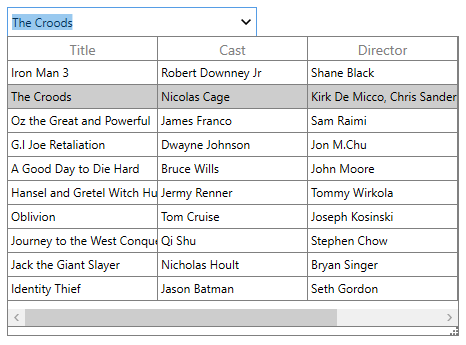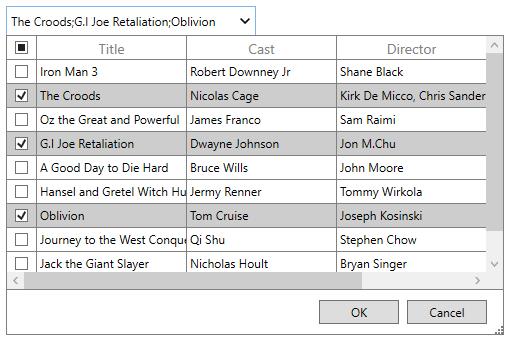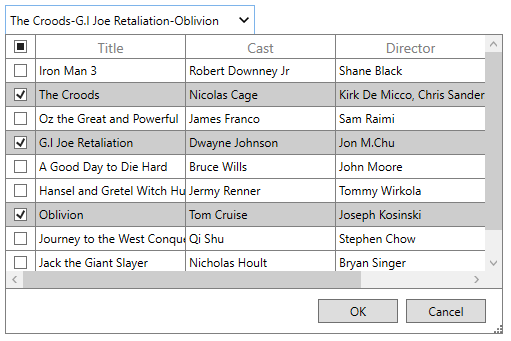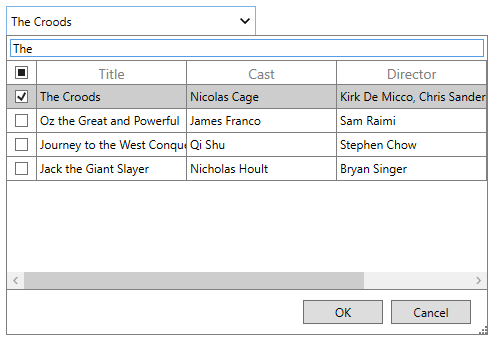Selection in WPF Multi Column Dropdown (SfMultiColumnDropDown)
18 Nov 202512 minutes to read
SfMultiColumnDropDownControl allows you to select one or more rows based on the SelectionMode. You can get the selected item in the SfDataGrid by using SelectedItem property and the selected index by using SelectedIndex property.
By using SelectedValue property, you can get the selected value from the selected item based on the ValueMember property.
Its recommend to use the SelectedItem and SelectedValue instead of using SelectedIndex to get the selected value.
By default, you can select only one item at a time from the dropdown, as the default value of SelectionMode is Single.
<syncfusion:SfMultiColumnDropDownControl x:Name="sfMultiColumn"
ItemsSource="{Binding Orders}"
ValueMember="CustomerID"
DisplayMember="CustomerName"
SelectionMode="Single">
</syncfusion:SfMultiColumnDropDownControl>using Syncfusion.UI.Xaml.Grid;
this.sfMultiColumn.SelectionMode = DropDownSelectionMode.Single;
Multi-Selection
You can select multiple rows at same time by setting SelectionMode as Multiple. Further, you can select multiple rows in the following ways
- By clicking on the respective rows.
- By dragging mouse on the dropdown grid.
- By using
Spacekey. -
By interacting with the checkbox in the
Selector column.<syncfusion:SfMultiColumnDropDownControl x:Name="sfMultiColumn" ItemsSource="{Binding Orders}" ValueMember="CustomerID" DisplayMember="CustomerName" SelectionMode="Multiple"> </syncfusion:SfMultiColumnDropDownControl>using Syncfusion.UI.Xaml.Grid; this.sfMultiColumn.SelectionMode = DropDownSelectionMode.Multiple;

NOTE
SelectedItem will be added, only after clicking on
Okbutton in the dropdown or by pressingEnterkey.SelectedItem,SelectedIndexandSelectedValuedenotes the first selected row.
Separator string customization
By default, selected values in the editor are separated by ;. You can change this string by setting SeparatorString property.
<syncfusion:SfMultiColumnDropDownControl x:Name="sfMultiColumn"
ItemsSource="{Binding Orders}"
SelectionMode="Multiple"
ValueMember="CustomerID"
DisplayMember="CustomerName"
SeparatorString="-">
</syncfusion:SfMultiColumnDropDownControl>using Syncfusion.UI.Xaml.Grid;
this.sfMultiColumn.SeparatorString = "-";
Accessing the selected items
The selected items can be retrieved by using the SelectedItems property. The selection can also be added programmatically by using the SelectedItems property.
Load custom control in drop-down
You can add custom header to the dropdown by setting HeaderTemplate property. For example, you can add textbox at the header of dropdown to search and filter items.
xmlns:interactivity="http://schemas.microsoft.com/expression/2010/interactivity"
<Window.Resources>
<local:MultiConverter x:Key="multiConverter"/>
<DataTemplate x:Key="headerTemplate">
<Border BorderThickness="0,0,0,1" BorderBrush="Gray">
<TextBox x:Name="searchTextBox" Margin="3" >
<interactivity:Interaction.Triggers>
<interactivity:EventTrigger EventName="TextChanged">
<interactivity:InvokeCommandAction Command="{Binding Path=DataContext.TextChanged, Source={x:Reference Name=sfMultiColumn}}" >
<interactivity:InvokeCommandAction.CommandParameter>
<MultiBinding Converter="{StaticResource multiConverter}">
<Binding Source="{x:Reference Name=sfMultiColumn}"/>
<Binding RelativeSource="{RelativeSource Mode=FindAncestor, AncestorType=TextBox}"/>
</MultiBinding>
</interactivity:InvokeCommandAction.CommandParameter>
</interactivity:InvokeCommandAction>
</interactivity:EventTrigger>
</interactivity:Interaction.Triggers>
</TextBox>
</Border>
</DataTemplate>
</Window.Resources>
<syncfusion:SfMultiColumnDropDownControl x:Name="sfMultiColumn"
DisplayMember="Title"
HeaderTemplate="{StaticResource headerTemplate}"
ItemsSource="{Binding MoviesLists}"
ValueMember="Cast"
SelectionMode="Multiple">
<interactivity:Interaction.Triggers>
<interactivity:EventTrigger EventName="PopupOpening">
<interactivity:InvokeCommandAction
Command="{Binding Path=DataContext.PopupOpening, ElementName=sfMultiColumn}"
CommandParameter="{Binding ElementName=sfMultiColumn}" />
</interactivity:EventTrigger>
</interactivity:Interaction.Triggers>
</syncfusion:SfMultiColumnDropDownControl>using Syncfusion.UI.Xaml.Grid;
using Syncfusion.UI.Xaml.Utility;
public BaseCommand TextChanged
{
get
{
if (textChanged == null)
textChanged = new BaseCommand(OnTextChangedExecuted);
return textChanged;
}
}
public BaseCommand PopupOpening
{
get
{
if (popupOpeningCommand == null)
popupOpeningCommand = new BaseCommand(OnPopupOpening);
return popupOpeningCommand;
}
}
private void OnTextChangedExecuted(object obj)
{
var param = (object[])obj;
var multiColumnDropDown = param[0] as SfMultiColumnDropDownControl;
searchTextBox = param[1] as TextBox;
var grid = multiColumnDropDown.GetDropDownGrid();
if (grid != null && grid.View != null && grid.View.Filter != null)
grid.View.RefreshFilter();
}
private void OnPopupOpening(object obj)
{
var multiColumnDropDown = obj as SfMultiColumnDropDownControl;
var grid = multiColumnDropDown.GetDropDownGrid();
if (grid != null)
grid.View.Filter = CustomerFilter;
}
private bool CustomerFilter(object item)
{
var movie = item as GrossingMoviesList;
return movie.Title.ToLower().Contains(searchTextBox.Text.ToLower());
}
internal class MultiConverter : IMultiValueConverter
{
public object Convert(object[] values, Type targetType, object parameter, CultureInfo culture)
{
return values.ToArray();
}
public object[] ConvertBack(object value, Type[] targetTypes, object parameter, CultureInfo culture)
{
throw new NotImplementedException();
}
}
You can refer Search with TextBox in DropDown section in this sample.
NOTE
You can load custom control in drop-down only when SelectionMode is Multiple.
Events
You can handle the selection operations in SfMultiColumnDropDownControl by using SelectionChanged event.
SelectionChanged
SelectionChanged event is fired when select the item in SfDataGrid. You can use this event to get the SelectedItem, SelectedValue. SelectionChangedEventArgs provides data for SelectionChanged event.
sfMultiColumn.SelectionChanged += MultiColumnDropDown_SelectionChanged;
void MultiColumnDropDown_SelectionChanged(object sender, Syncfusion.UI.Xaml.Grid.SelectionChangedEventArgs args)
{
var selectedValue = (sender as SfMultiColumnDropDownControl).SelectedValue;
}NOTE
SelectionChanged event will not be triggered when SelectionMode is Multiple.